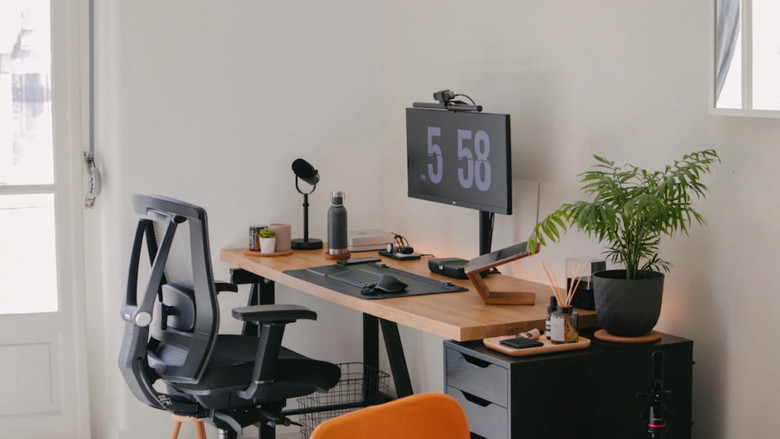Working from home is transforming our careers. A successful transition from the workplace to working from home requires more than just a free desk and a laptop. Managing your tech ecosystem is essential for survival and success. A comfortable and productive home office is essential, built on hardware and software that improve focus, well-being, and productivity. It’s more than just a powerful computer; it’s about creating an integrated environment that supports your body, streamlines your workflow, and protects your mental space from distractions at home. The right technology fundamentals can extend your career, improve your physical health, and increase your job satisfaction. Let’s take a look at the essentials for making your makeshift office space productive and comfortable.
Hidden Fundamentals: Ergonomic Furniture
Before we even start work, your chair and desk are crucial. An ergonomic chair with firm lumbar support, adjustable armrests, and breathable mesh is essential for maintaining optimal posture and circulation during a long workday. Combining a height-adjustable standing desk with a desk is crucial for better health and productivity. Changing your posture can reduce back pain, lessen a sedentary lifestyle, and improve your energy and focus. This powerful, yet often overlooked, combination—the cornerstone of all technology—ensures your body doesn’t pay the price for your professional performance.
Command Center: Computers and Monitors
Your computer is the brain of your work, so its performance impacts your efficiency. Consider using a desktop or laptop docking station as your primary desk setup to permanently connect peripherals with a single cable. A powerful laptop is portable. Monitor configuration is crucial. One monitor can limit productivity, while two or one ultrawide curved monitor can increase it. Numerous studies have indicated that multiple monitors can significantly reduce the time it takes to switch between windows, speeding up coding, writing, data processing, and creative design tasks. For better color accuracy and wider viewing angles, choose a monitor with an IPS panel and position it at or slightly below eye level to reduce neck strain.
Crystal Clear Communication: Audio and Video Gear
During video conferences, audio and video quality are crucial for how your colleagues perceive your professionalism. Laptop microphones and webcams can pick up ambient noise, resulting in poor image quality and low light. A Blue Yeti or Rode NT-USB microphone can make your voice clearer and reduce interference on incoming calls. A Logitech Brio 1080p or 4K webcam, thanks to its larger sensor, captures sharp video and performs excellently in low-light environments. The third step is excellent lighting; placing a ring light or softbox in front of you can reduce shadows, making you look more professional and dynamic, and enhancing your digital presence.
Avoid Network Distractions: Power and Connectivity
Working from home requires a fast and reliable network connection. For critical work, Ethernet is always preferable to Wi-Fi due to its lower latency, greater stability, and better security. If installing an Ethernet cable isn’t feasible, invest in a high-quality Wi-Fi 6 or 6E router for a strong, stable signal throughout your home. Power management is crucial. Simple power strips can be cluttered and annoying. A reliable surge protector can protect expensive equipment from power surges, while a UPS (Uninterruptible Power Supply) provides a battery backup to save your work and quickly shut down during a short outage, preventing data loss.
Subtle Protection: Health and Environmental Technology
Productivity encompasses both output and sustainability, preventing burnout. The atmosphere in your home office is crucial. A high-quality air purifier can minimize dust, allergens, and other particulate matter, improving cognitive performance and reducing allergies. Noise control is crucial. If you can’t control ambient noise like traffic or noisy neighbors, noise-canceling headphones can create a quiet environment for deep focus. In dry areas, using a small desktop humidifier can prevent dry skin and sinus infections. These technologies protect your health by creating a comfortable and productive work environment.
Automated Efficiency: Smart Home Integration
Use smart home technology to streamline your workflow. Smart plugs can precisely control the timing of your desk lamp, improving your work schedule. Smart thermostats can maintain a comfortable indoor temperature without leaving your desk. Smart light bulbs can adjust the light temperature throughout the day: cool blue light in the early morning promotes concentration, while warm yellow light in the afternoon reduces eye strain and supports your circadian rhythm. Smart speakers can set timers, manage your calendar, and play background music without disturbing your computer.
The Digital Workspace: Software and Security
Physical technology is useless without digital tools. Invest in project management software like Asana or Trello, communication platforms like Slack or Microsoft Teams, and cloud storage like Google Drive or Dropbox to improve collaboration. Security shouldn’t be overlooked. You’ll need a reliable password manager to create and store strong, unique passwords for each service. Always use a VPN when connecting to public Wi-Fi, and consider using one on your home network for added encryption, especially when managing important work data. Digital security is your responsibility.
Conclusion:
Creating the perfect home office is a personal and iterative process that evolves with your role, tasks, and preferences. The key is to wisely choose technology that addresses your pain points and amplifies your strengths. From ergonomic bases that protect your body to powerful software that organizes your mind, every aspect should enhance your work life. A well-designed workspace promotes flexibility, reduces daily friction, and defines your professional and personal life. Consider your home office a long-term investment in your work and health so you can perform at your best and work comfortably and productively.
FAQs:
1. What’s the most important tech upgrade for your home office?
A reliable computer is important, but an ergonomic chair and a height-adjustable standing desk are the best choices for long-term health and comfort. This combination immediately combats the physical strain of prolonged sitting, prevents back pain and fatigue, and ensures better productivity and well-being than a faster processor.
2. I have a limited budget; where should I start?
Upgrades that affect daily comfort and workflow are the top priority. An additional monitor can significantly improve productivity at a reasonable price. Invest in a USB microphone for clearer conversations. Before investing in more expensive options, you can find affordable monitor arms and LED desk lamps to improve ergonomics and lighting.
3. Is the Wi-Fi sufficient? Should I consider using an Ethernet cable instead?
A stable Wi-Fi 6 connection is sufficient for most work needs. Wired Ethernet is more reliable, faster, and more secure for videoconferencing, large file transfers, online gaming, and real-time communication. It eliminates signal degradation and latency, ensuring a reliable connection.
4. Why do I need a UPS?
A UPS protects against power outages and voltage drops. It provides a few minutes of battery life, allowing you to save your work, close apps, and gracefully shut down your computer. This simple device can prevent catastrophic data loss and hardware damage.
5. Can smart home devices increase productivity?
Smart devices can automatically control the environment, reducing cognitive load and physical exertion. Smart plugs can control lighting schedules, smart thermostats can maintain comfort without distraction, and smart speakers can set hands-free timers and reminders. This simplifies work and increases efficiency.




